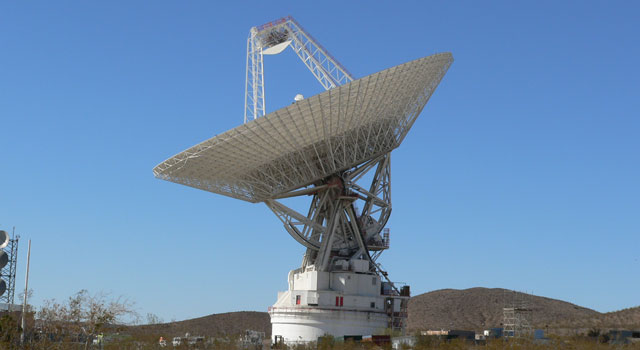| Home | Orbit | Satellite | Power Link | Comm Link | Earth Stations | Cost/Timeline | Employees |
Methodology
Because there is only one Earth Station, during the night-time hours communication directly to the solar satellites is impossible. As such, all night-time communication will relay through the GEO Satellite as part of an ad-hoc network. Because of both the financial and militaristic assets the satellites provide, the channel must prove jam resistant and provide substantial levels of encryption and authentication. As such, similar methods as military radio communication systems are used.
This link will be used to provide station keeping instructions to the satellites, as well as monitor health and other information. As the whole constellation is being assembled over the ten year period, it will allow for modifications to the communication routine to allow the new satellites to be incorporated. It will also allow for targeting information to be passed to the satellites in the Halo orbit.
This target information will keep the power transmission lasers directed at the GEO relay satellite, but will also be able to provide arbitrary targets. Arbitrary targeting information provides additional flexibility and expandability of the system by allowing additional GEO relay satellites to be launched in the future. This could provide the capability to dynamically allocate power to any added Earth station, along with providing a weaponized use of the system.
The LEO satellite will act as a bent-pipe relay in order to minimize local power requirements since only communication at night needs to be relayed. All communication during the day will be conducted directly with the harvesting satellites.
Protocol
To facilitate the goals of a secure, jam-resistant communication system with the capabilities to dynamically add additional authenticated users, the system will use military methodology. A CDMA coded QPSK system using a half-rate turbo code for forward error correction would be used. A 128-bit AES end to end encryption with the capability to over the air rekey would be added to further secure the link. While there are initially only three users on the network (the Earth Station, the GEO Satellite, and a single Solar Satellite), there is a known minimum desired (92). This provides a base number for the number of unique codes required on the network. The X-band would be used for communication due to it already being allocated, in part, for deep space communication and because of its resistance to atmospheric effects. The exact frequency range would have to be granted by the ITU, but nominally will be considered 10GHz.
Using a data rate of 68kbits/s in a 100kHz bandwidth with a 0.35 roll off, gives a symbol rate of 74ksymbols/s. With a chip rate of 740,000 chips/s there is a processing gain of 10, and the link uses 1Mhz of bandwidth.

Sizing and Power
In order to communicate directly with the harvesting satellites, a 70 meter Earth station dish will be used. This is the same size dish used by NASA as part of the DSN to communicate with space probes.
The dishes on the satellites will be 10 meters. The harvesting satellites will each require one dish, while the LEO satellite will require two. One will be aimed at the Earth station, and the other will be aimed at the Halo point.
Using these dish sizes in the worst case situation of communicating through the LEO satellite yields a transmission power requirement of 650W at the Shannon limit with a BER of 10-7. By location of the Earth station atmospheric effects and fading will be minimized. Using a transmission power of 1.5kW would yield sufficient overage to account for the channel not being at ideal capacity while still being at a reasonable power limit.